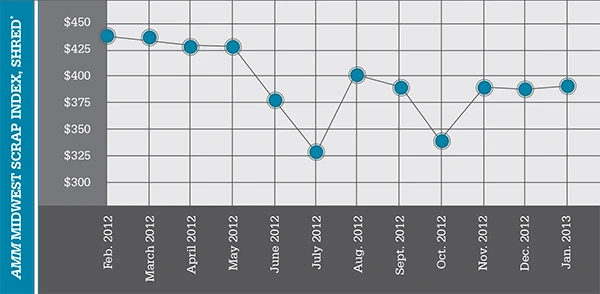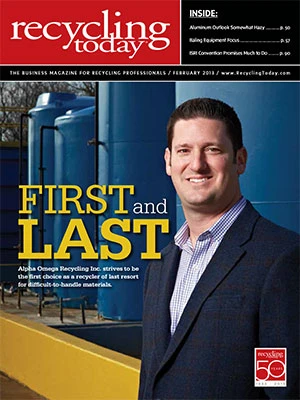
Ferrous scrap recyclers in North America continued to operate in a “steady as she goes” market as the new calendar year started. Domestic mill demand is not booming but is in step with the lagging pace of supply. Export demand has remained consistent, with Turkish mills placing orders on the Atlantic Coast and South Korean buyers being cited as a steady presence by recyclers on the Pacific Coast.
Scrap generation offers a few bright spots, depending on the grade and region, though the construction and demolition sectors remain among the most beleaguered segments of the U.S. economy.
America’s oil and natural gas booms are keeping scrap orders strong at pipe foundries and tube mills and generation steady in oil fields. While traditional oil-producing states such as Texas and Oklahoma are home to new drill sites and are pumping out steady volumes of crude oil, North Dakota has emerged as the second-largest oil producer in the lower 48, behind only Texas.
Statistics from the U.S. Energy Information Administration (www.eia.gov) show North Dakota has grown from producing 39.9 million barrels of oil in 2006 to 153 million in 2011, marking a 283 percent increase in production.
The state’s 2 percent unemployment rate is owed largely to this oil boom, which is credited to new extraction and recovery techniques and a floor price for petroleum that gave energy companies the confidence to invest there. The result in North Dakota has been not only the generation of oil field scrap but also one of the few booming housing and construction markets yielding healthy quantities of scrap.
Construction activity in most other states, however, remains in a mode of very slow recovery from the trough years of 2008 and 2009. Tepid optimism might best describe the construction employment forecast for the Arlington, Va.-based Associated General Contractors of America (AGC) industry trade group for 2013.
In an annual forecast released in mid-January, the group says, “Significantly more construction firms are planning to add new staff than plan to cut staff, while demand for many types of private sector construction projects should increase this year, according to survey results.”

The AGC (www.agc.org) titled the report accompanying its survey results “Tentative Signs of a Recovery: The 2013 Construction Industry Hiring and Business Outlook.”
“While the outlook for the construction industry appears to be heading in the right direction for 2013, many firms are still grappling with significant economic headwinds,” says Stephen E. Sandherr, the association’s CEO. “With luck and a lot of work, the hard-hit construction industry should be larger, healthier, more technologically savvy and more profitable by the end of 2013 than it is today.”
Contractors appear increasingly optimistic that demand for certain private sector projects will expand this year, according to Sandherr. Firms are most optimistic about the outlook for hospital and higher education construction, he adds. Contractors also signaled optimism about the markets for power construction. On the other hand, they had lower expectations for manufacturing, private office and retail, warehouse and hotel construction.
Contractors also anticipate that demand for public construction will decline in 2013, with the AGC noting that 40 percent of responding firms say tighter lending conditions have forced customers to delay or to cancel such projects.
“Unfortunately, there are almost as many causes for concern as there are signs of optimism,” says Ken Simonson, AGC chief economist.
One scrap broker contacted says he sees little reason for his company to budget for increased ferrous scrap flows in 2013. He cites increased shredder competition and the lukewarm construction market as the main reasons.
For shredder operators, the automotive market offers better news, with research firm R.L. Polk & Co., Southfield, Mich., forecasting between 15.3 million and 15.4 million new vehicle registrations in the United States in 2013. That is an improvement compared with the 14.4 million new vehicles registered in 2012.
A January write-up in the Wall Street Journal indicates that “barring a slowdown in the U.S. economy, new vehicle sales are expected to surpass the 16 million mark in 2014. The last time the U.S. auto industry sold 16 million vehicles was in 2007.”
On the demand side, domestic mills are operating at a capacity utilization rate of 75.9 percent, according to the American Iron & Steel Institute, Washington, D.C., which is down from the 77.6 percent rate at which they were operating in the second week of January 2012.


Explore the February 2013 Issue
Check out more from this issue and find your next story to read.
Latest from Recycling Today
- Orion ramping up Rocky Mountain Steel rail line
- Proposed bill would provide ‘regulatory clarity’ for chemical recycling
- Alberta Ag-Plastic pilot program continues, expands with renewed funding
- ReMA urges open intra-North American scrap trade
- Axium awarded by regional organization
- Update: China to introduce steel export quotas
- Thyssenkrupp idles capacity in Europe
- Phoenix Technologies closes Ohio rPET facility





